Grid computing is the use of widely distributed computer resources to reach a common goal. A computing grid can be thought of as a distributed system with non-interactive workloads that involve many files. Grid computing is distinguished from conventional high-performance computing systems such as cluster computing in that grid computers have each node set to perform a different task/application. Grid computers also tend to be more heterogeneous and geographically dispersed than cluster computers. Although a single grid can be dedicated to a particular application, commonly a grid is used for a variety of purposes. Grids are often constructed with general-purpose grid middleware software libraries. Grid sizes can be quite large.
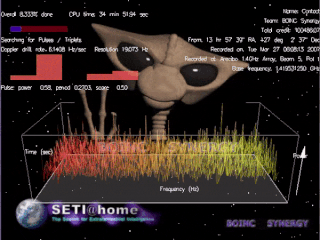
SETI@home is a project of the Berkeley SETI Research Center to analyze radio signals with the aim of searching for signs of extraterrestrial intelligence. Until March 2020, it was run as an Internet-based public volunteer computing project that employed the BOINC software platform. It is hosted by the Space Sciences Laboratory at the University of California, Berkeley, and is one of many activities undertaken as part of the worldwide SETI effort.

The Berkeley Open Infrastructure for Network Computing is an open-source middleware system for volunteer computing. Developed originally to support SETI@home, it became the platform for many other applications in areas as diverse as medicine, molecular biology, mathematics, linguistics, climatology, environmental science, and astrophysics, among others. The purpose of BOINC is to enable researchers to utilize processing resources of personal computers and other devices around the world.

Predictor@home was a volunteer computing project that used BOINC software to predict protein structure from protein sequence in the context of the 6th biannual CASP, or Critical Assessment of Techniques for Protein Structure Prediction. A major goal of the project was the testing and evaluating of new algorithms to predict both known and unknown protein structures.

World Community Grid (WCG) is an effort to create the world's largest volunteer computing platform to tackle scientific research that benefits humanity. Launched on November 16, 2004, with proprietary Grid MP client from United Devices and adding support for Berkeley Open Infrastructure for Network Computing (BOINC) in 2005, World Community Grid eventually discontinued the Grid MP client and consolidated on the BOINC platform in 2008. In September 2021, it was announced that IBM transferred ownership to the Krembil Research Institute of University Health Network in Toronto, Ontario.

LHC@home is a volunteer computing project researching particle physics that uses the Berkeley Open Infrastructure for Network Computing (BOINC) platform. The project's computing power is utilized by physicists at CERN in support of the Large Hadron Collider and other experimental particle accelerators.

Big and Ugly Rendering Project (BURP) is a non-commercial volunteer computing project using the BOINC framework for the rendering of 3D graphics that has been in hibernation as of 2020. The project website currently shows the status as "extended maintenance" until 2027.

Within the BOINC platform for volunteer computing, the BOINC Credit System helps volunteers keep track of how much CPU time they have donated to various projects. This ensures users are returning accurate results for both scientific and statistical reasons.

United Devices, Inc. was a privately held, commercial volunteer computing company that focused on the use of grid computing to manage high-performance computing systems and enterprise cluster management. Its products and services allowed users to "allocate workloads to computers and devices throughout enterprises, aggregating computing power that would normally go unused." It operated under the name Univa UD for a time, after merging with Univa on September 17, 2007.

David Pope Anderson is an American research scientist at the Space Sciences Laboratory, at the University of California, Berkeley, and an adjunct professor of computer science at the University of Houston. Anderson leads the SETI@home, BOINC, Bossa, and Bolt software projects.
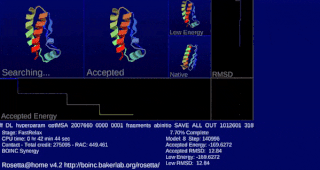
Rosetta@home is a volunteer computing project researching protein structure prediction on the Berkeley Open Infrastructure for Network Computing (BOINC) platform, run by the Baker lab. Rosetta@home aims to predict protein–protein docking and design new proteins with the help of about fifty-five thousand active volunteered computers processing at over 487,946 GigaFLOPS on average as of September 19, 2020. Foldit, a Rosetta@home videogame, aims to reach these goals with a crowdsourcing approach. Though much of the project is oriented toward basic research to improve the accuracy and robustness of proteomics methods, Rosetta@home also does applied research on malaria, Alzheimer's disease, and other pathologies.
The Lattice Project was a volunteer computing project that combined computing resources, Grid middleware, specialized scientific application software and web services into a comprehensive Grid computing system for scientific analysis. It ran the Genetic Algorithm for Rapid Likelihood Inference (GARLI) software to determine the relationships between different genetic samples.
SZTAKI Desktop Grid (SzDG) was a BOINC project located in Hungary run by the Computer and Automation Research Institute (SZTAKI) of the Hungarian Academy of Sciences. It closed on June 21, 2018.

Volunteer computing is a type of distributed computing in which people donate their computers' unused resources to a research-oriented project, and sometimes in exchange for credit points. The fundamental idea behind it is that a modern desktop computer is sufficiently powerful to perform billions of operations a second, but for most users only between 10–15% of its capacity is used. Common tasks such as word processing or web browsing leave the computer mostly idle.

MilkyWay@home is a volunteer computing project in the astrophysics category, running on the Berkeley Open Infrastructure for Network Computing (BOINC) platform. Using spare computing power from over 38,000 computers run by over 27,000 active volunteers as of November 2011, the MilkyWay@home project aims to generate accurate three-dimensional dynamic models of stellar streams in the immediate vicinity of the Milky Way. With SETI@home and Einstein@home, it is the third computing project of this type that has the investigation of phenomena in interstellar space as its primary purpose. Its secondary objective is to develop and optimize algorithms for volunteer computing.
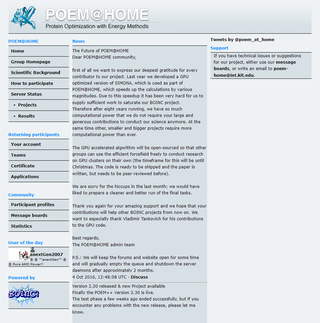
POEM@Home was a volunteer computing project hosted by the Karlsruhe Institute of Technology and running on the Berkeley Open Infrastructure for Network Computing (BOINC) software platform. It modeled protein folding using Anfinsen's dogma. POEM@Home was started in 2007 and, due to advances using GPUs that rendered the BOINC program redundant, concluded in October 2016. The POEM@home applications were proprietary.
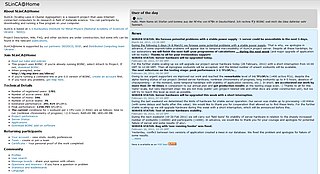
SLinCA@Home was a research project that uses Internet-connected computers to do research in fields such as physics and materials science.
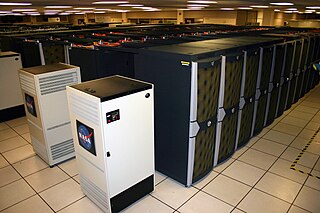
Quasi-opportunistic supercomputing is a computational paradigm for supercomputing on a large number of geographically disperse computers. Quasi-opportunistic supercomputing aims to provide a higher quality of service than opportunistic resource sharing.

OProject@Home was a volunteer computing project running on the Berkeley Open Infrastructure for Network Computing (BOINC) and was based on a dedicated library OLib. The project was directed by Lukasz Swierczewski, an IT student at the College of Computer Science and Business Administration in Łomża, Computer Science and Automation Institute. As of 2016 it seems to have been abandoned.

theSkyNet was a research project that used volunteer Internet-connected computers to carry out research in astronomy. It was an initiative of the International Centre for Radio Astronomy Research (ICRAR), a joint venture of Curtin University and the University of Western Australia. theSkyNet had two projects, Sourcefinder and POGS. Both projects have been completed. theSkyNet Sourcefinder aimed to test and refine automatic radio sourcefinding algorithms in preparation for radio galaxy surveys using the Australian Square Kilometre Array Pathfinder and the Square Kilometre Array. theSkyNet POGS used Spectral Energy Distribution fitting to calculate characteristics of many galaxies using images taken by the Pan-STARRS PS1 optical telescope in Hawaii.
















